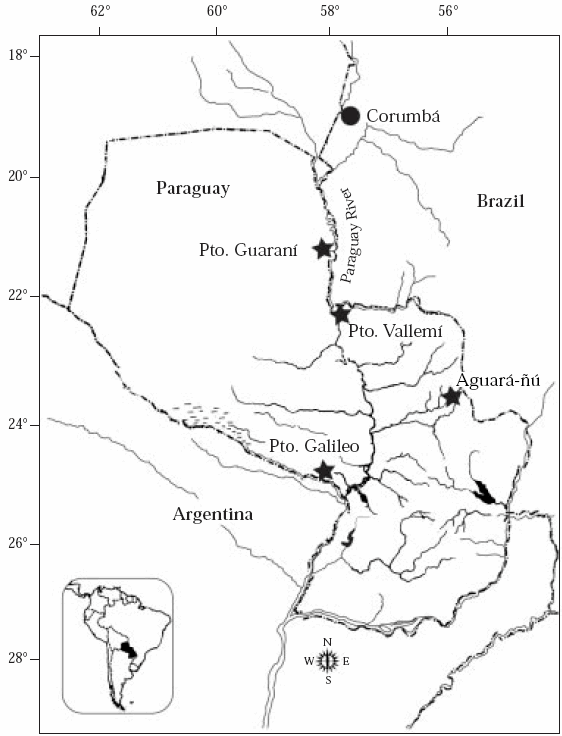Servicios Personalizados
Revista
Articulo
Indicadores
-
 Citado por SciELO
Citado por SciELO
Links relacionados
-
 Similares en
SciELO
Similares en
SciELO  uBio
uBio
Compartir
Revista de la Sociedad Entomológica Argentina
versión impresa ISSN 0373-5680versión On-line ISSN 1851-7471
Rev. Soc. Entomol. Argent. v.63 n.1-2 Mendoza ene./jul. 2004
New distributional records and comments for the species of the genus Queda (Coleoptera: Dytiscidae)
Nuevos registros distribucionales y comentarios para las especies del género Queda (Coleoptera, Dytiscidae)
Trémouilles, Edgardo R.*, ***, Patricia L. M. Torres** and Mariano C. Michat**,***
*Museo Argentino de Ciencias Naturales 'Bernardino Rivadavia'. Av. Ángel Gallardo 470, C1405DJR, Buenos Aires, Argentina; e-mail: edgtrem@muanbe.gov.ar
**Departamento de Biodiversidad y Biología Experimental, Facultad de Ciencias Exactas y Naturales, Univ. Buenos Aires. Av. Intendente Güiraldes 2160, C1428EHA, Buenos Aires, Argentina; e-mail: patorres74@bg.fcen.uba.ar
***CONICET.
ABSTRACT. New distributional records for the species of the genus Queda Sharp are presented based on the examination of the Dytiscid collection at the Museo Argentino de Ciencias Naturales. The presence of the genus in Paraguay is herein reported for the first time. Some additional data on the identified species are also provided.
KEY WORDS. Dytiscidae. Hydrovatini. Queda. Neotropical region.
RESUMEN. Se aportan nuevos registros sobre distribución geográfica de las especies del género Queda Sharp, basados sobre el examen de la colección de Dytiscidae del Museo Argentino de Ciencias Naturales. La presencia del género en el Paraguay es reportada aquí por primera vez. Se proporciona información adicional sobre las especies identificadas.
PALABRAS CLAVE. Dytiscidae. Hydrovatini. Queda. Región Neotropical.
The Neotropical genus Queda Sharp conforms, along with Hydrovatus Motschulsky, the Hydroporinae tribe Hydrovatini. According to Biström (1990) this tribe can be distinguished from other Hydroporinae by the following diagnostic combination: base of trochanter partially hidden by the laterodistal portion of metacoxal process; pronotum without longitudinal, lateral impressed lines; metatarsal claws similar; prosternal process triangular, with apex broad; mesocoxae widely separated; metacoxal process with an excision on the posterior margin. The genus Queda is distinguished from Hydrovatus by the following characters (Biström, 1990): metacoxal excision shorter longitudinally than transversally; labrum not visible; body not acuminate apically; lack of a stridulatory apparatus which is present ventrally in some Hydrovatus species.
Since Sharp (1882) created the genus, describing Queda compressa Sharp from Brazil (type species of the genus by monotypy) it has been treated by few authors. Zimmermann (1921) described Queda hydrovatoides Zimmermann from Brazil (Corumbá), and Biström (1990) revised the genus describing another species, Q. youngi Biström, from Brazil, Panamá, and Venezuela.
The phylogenetic placement of Queda within Hydrovatini has been questioned by Wolfe (1985, 1988). Based mainly on the shape of the eighth abdominal tergite, he suggested this resemble those found in more plesiotypic hydroporines. This point of view was recently rejected by other authors, whose results support the monophyly of Hydrovatus plus Queda based on characteristics of the female reproductive system (Miller, 2001) and the prosternal process (Biström, 1996; see also Biström, 1990). Though the phylogenetic position of members of Hydrovatini is a point of some controversy, the monophyly of Queda seems to be a topic of little discussion.
Examination of the Dytiscid collection held at the Museo Argentino de Ciencias Naturales allowed us to identify some specimens of Queda coming from localities that are new distributional records for the genus. The specimens were identified using the key of Biström (1990).
Five specimens of Q. youngi and two of Q. hydrovatoides were identified. Regarding Q. youngi, the measurements of the total length given by Biström (1990) range from 5.0 to 6.2 mm, but two of the examined specimens are somewhat smaller, their length are 4.8 and 4.9 mm. The collecting localities are the first records for the genus in Paraguay. Due to the proximity of Puerto Galileo to the argentine boundary, and to the lack of a geographic barrier between both countries in that area, this species is expected to occur in the Northern provinces of Argentina.
Regarding Q. hydrovatoides , the labelling of the specimens suggests that they belong to the series on which Zimmermann (1921) described the species. Measurements of total length and maximun width for these individuals range 2.49-2.52 mm and 1.59-1.74 mm respectively.
Material examined:
Queda youngi Biström: PARAGUAY: 1 male, Pto. Guaraní, VII-1928, col. J.B. Daguerre; 1 male and 2 females, Dto. Concepción, Pto. Vallemí, VI-1952, col. A.O. Bachmann; 1 female, Dto. Pte. Hayes, Pto. Galileo, 23-II-2003, col. O.R. Di Iorio; 1 male, Aguará-ñú, 15-XII-03 Trampa luz mercurio, col. O.R. Di Iorio.
Queda hydrovatoides Zimmermann: BRAZIL: 2 specimens from Mato Grosso - Corumbá "Cotypus" [light blue cardboard], " Queda hydrovatoides Zimmermann" [handwritten], " Queda hydrovatoides Zimm." [handwritten, probably by Zimmermann], col. C. Bruch.
Geographic distribution
Q. compressa: Brazil; Q. hydrovatoides: Brazil; Q. youngi: Panamá, Venezuela, Brazil, Paraguay (new country record). New distributional records are shown in Fig. 1.

Fig. 1. Distributional records for the species of the genus Queda Sharp. Star, Q. youngi; Dot, Q. hydrovatoides.
LITERATURE CITED
1. BISTRÖM, O. 1990. Revision of the genus Queda Sharp (Coleoptera, Dytiscidae). Quaest. entom. 26: 211-220. [ Links ]
2. BISTRÖM, O. 1996. Taxonomic revision of the genus Hydrovatus Motschulsky (Coleoptera, Dytiscidae). Entomol. Basil. 19: 57-584. [ Links ]
3. MILLER, K. B. 2001. On the phylogeny of the Dytiscidae (Insecta: Coleoptera) with emphasis on the morphology of the female reproductive system. Insect Syst. Evol. 32(1): 45-92. [ Links ]
4. SHARP, D. 1882. On aquatic carnivorous Coleoptera or Dytiscidae. Sc. Trans. Roy. Dublin Soc. 2: 179-1003. [ Links ]
5. WOLFE, G. W. 1985. A phylogenetic analysis of plesiotypic Hydroporinae lineages with an emphasis on Laccornis Des Gozis (Coleoptera: Dytiscidae). Proc. Acad. Nat. Sc. Philadelphia 137: 132-155. [ Links ]
6. WOLFE, G. W. 1988. A phylogenetic investigation of Hydrovatus , Methlini and other plesiotypic hydroporines (Coleoptera: Dytiscidae). Psyche 95:61-71. [ Links ]
7. ZIMMERMANN, A. 1921. Beiträge zur Kenntnis der südamerikanischen Schwimmkäferfauna nebst 41 Neubeschreibungen. Arch. Naturg. 87A (3): 181-206. [ Links ]
Recibido: 19-XI-2003
Aceptado: 29-III-2004














